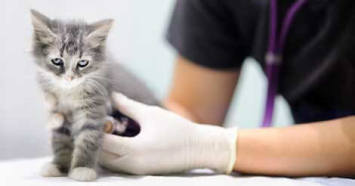
Why does my kitten need shots?
Shots, or vaccines, are injections used to protect kittens from certain diseases or illnesses. Vaccines trigger the kitten’s immune system to make antibodies against a disease, which generally prevents the kitten from getting sick should he or she be exposed to the disease in the future. Most shots will need to be repeated several times to ensure that the immune system is fully ready and strong enough to prevent illness.
When do kittens need shots?
A kitten vaccination schedule usually involves vaccines first being given between 6 to 8 weeks of age, followed by vaccine boosters every 2-4 weeks until the kitten is around 16 weeks of age.
Kitten Vaccination Schedule
This chart is an example of when each vaccine is given based on your kitten’s age. Manufacturer and type of vaccine your veterinarian uses, local and state laws, and your kitten’s environment may affect how often or when to give each vaccine. If your kitten doesn’t start his or her shots right away, your veterinarian will be able to determine the best adjusted vaccine schedule to ensure the kitten will still be well protected.
As your kitten grows, it will require vaccines throughout its life. The vaccination schedule for an adult cat is not as frequent, but still very important.
What shots do kittens need?
Kitten shots include vaccines for many diseases. Usually several diseases are combined together into one vaccine vial to decrease the number of shot injections a kitten needs (“4-in-1 combo vaccine”).
Feline Panleukopenia virus (“Feline Parvo” or “Feline Distemper”): Highly-contagious virus spread between cats. Not the same disease as parvo or distemper in dogs. Panleukopenia virus can cause symptoms such as vomiting, diarrhea, and unwillingness to move around. Panluekopenia virus can be deadly. Most types of panleukopenia vaccinations will fully prevent disease and its spread.
Feline Herpesvirus (“Herpes” or “Feline Viral Rhinotracheitis”): Highly-contagious virus spread among cats. Not a sexually transmitted disease (STD) in cats. Herpes symptoms can include runny nose or eyes, eye ulcers, sneezing, or coughing. Herpesvirus is usually not deadly, but symptoms may reappear during times of stress. Vaccination may not fully prevent the disease from occurring, but the vaccine will help prevent major illness symptoms.
Feline Calicivirus: Contagious virus spread between cats. Calicivirus symptoms include runny eyes, runny nose, sneezing, and mouth ulcers. Although generally not deadly, the disease can be quite painful if mouth ulcers occur. Vaccination may not fully prevent the disease from occurring, but the vaccine will help prevent major illness symptoms.
Rabies Virus: Rabies virus is usually spread by a bite from an infected or “rabid” animal. Many animals are susceptible to rabies, including humans. Neurologic symptoms are common, such as unusual behavior, unexpected aggression, drooling, wobbliness when walking, or inability to walk. Rabies is extremely deadly. Vaccination generally prevents disease and its spread.
Chlamydophila felis (“Chlamydia”): Contagious bacteria spread among cats. Not an STD in cats. Chlamydia symptoms include swollen or runny eyes, conjunctivitis, sneezing, and runny nose. While usually not deadly, symptoms can be severe and may reappear periodically. Vaccination may not fully prevent the disease from occurring, but the vaccine will help prevent major illness symptoms.
Bordetella bronchiseptica: Contagious bacteria that causes respiratory disease among dogs and sometimes cats. Symptoms include coughing and runny nose. Pets are more likely to be exposed after staying in close contact with large groups of dogs and cats, such as boarding facilities. While Bordetella is rarely deadly, symptoms such as coughing, may last for weeks to months. Vaccination may not fully prevent the disease from occurring, but the vaccine will help prevent major illness symptoms.
Feline Leukemia Virus (“FeLV”): Contagious virus spread among cats through saliva (eg, grooming each other, sharing food and water bowls). Infected cats can sometimes live with non-infected cats without spreading the virus. FeLV decreases the immune system’s ability to fight infection, leading to more frequent illnesses. FeLV has also been shown to cause cancer. Cats may be infected for many years before showing symptoms, which include sneezing, runny eyes and nose, laying around, poor appetite, and pale skin and gums. Once symptoms occur, FeLV can be deadly. Vaccination may not fully prevent the disease from occurring, but the vaccine will help prevent major illness symptoms.
*Rabies vaccine can be given as early as 12 weeks of age, but may be given later, at 16 weeks of age depending on local and state laws. It is only given once in the kitten vaccine series. **Bordetella vaccine can be given as early as 4 weeks of age if the kitten is or has been in a high risk environment, such as a shelter. Depending on the type of vaccine, boostering (re-vaccinating) more than once during the kitten shot schedule may or may not be needed. ***FeLV can be given as early as 8 weeks of age, but only requires 2 doses during the kitten shot schedule, at 2-4 weeks apart. Getting your kitten vaccinated is a very important part of its overall health care plan. Immunizations are essential to protect your kitten from a variety of diseases and illnesses.